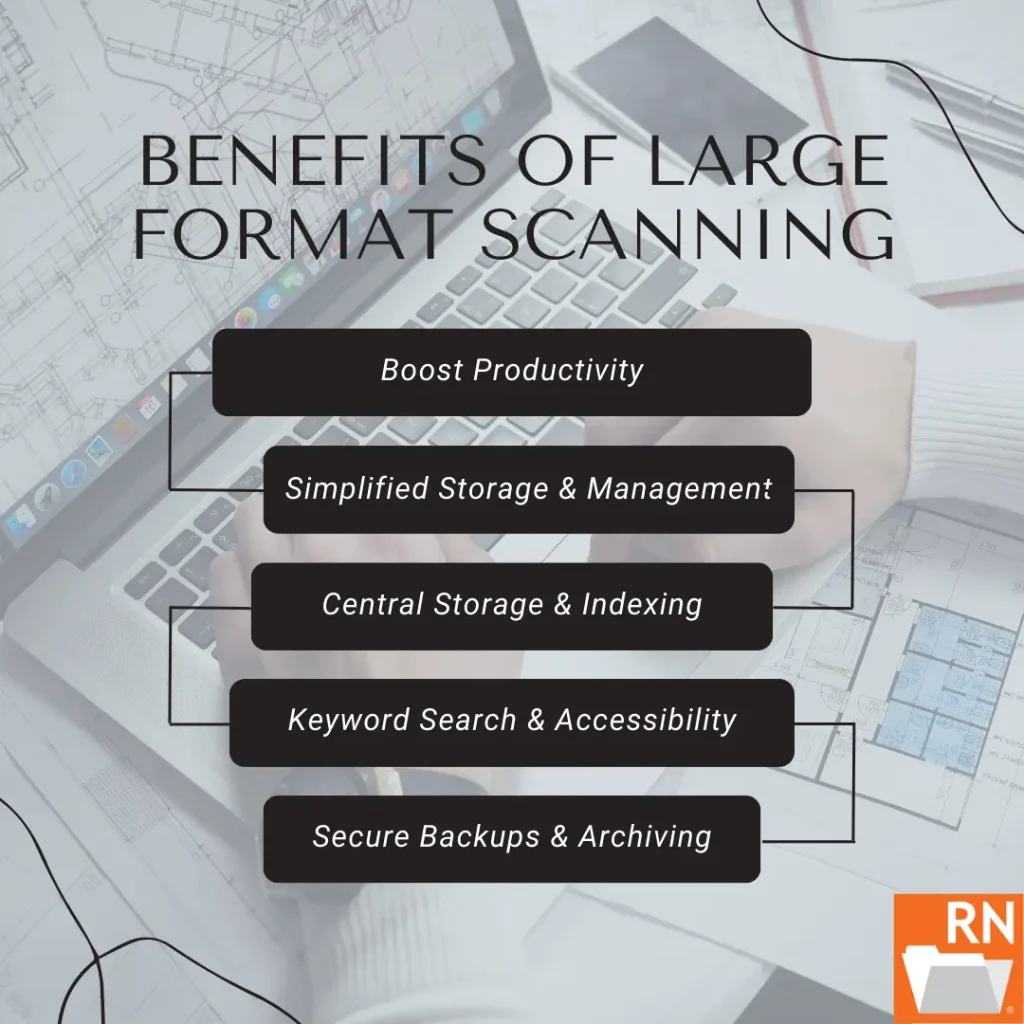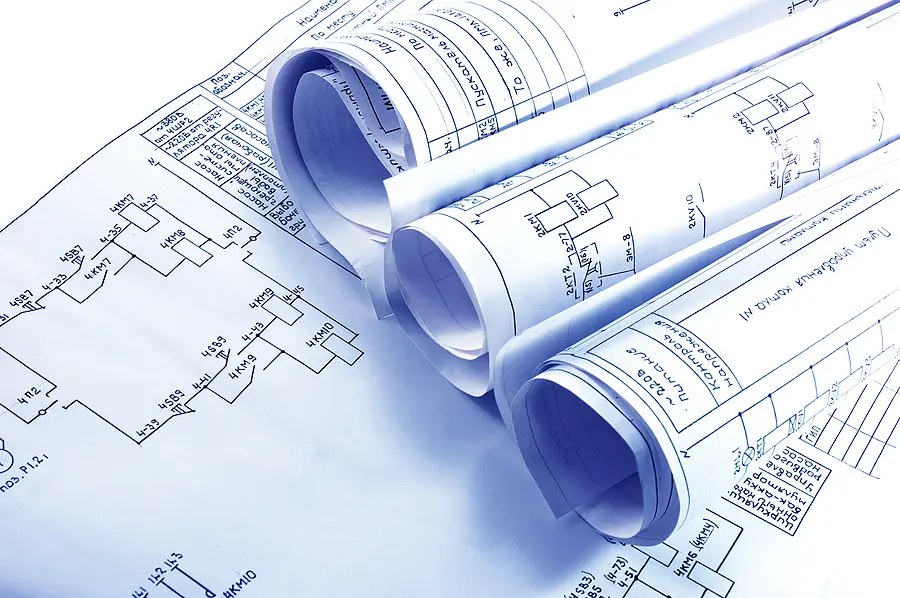
Devices that provide combined scanning, printing, and copying services are common in office spaces. However, these devices generally can’t handle anything beyond standard-sized documents. Even if your office doesn’t own a device like this, it’s often available to use, for a price, at local office supply stores or scanning companies.
What Is Large Format Scanning, And Why Is It Important?
However, if you need to scan documents outside these standard sizes, these services may be more difficult to find. Newspapers, architectural drawings, engineering diagrams, maps, and other large format documents larger than A4 (8.3″ x 11.7″) are just some documents that often need a specialized device to convert to a digital format. Scanning these large-format documents helps free up storage space, protect them from damage, and reduce other resources involved in managing them.
Preserving these documents is often crucial, as they contain vital information that needs to be stored for years. They will often have already been in physical format for significant periods and are at risk of damage or staining. Old architectural drawings, for instance, need to be protected as the buildings they represent can stand for decades or longer. Every time they’re unrolled, transferred, or moved from place to place, they risk becoming damaged or destroyed.
Scanning them into a digital format eliminates this risk and allows them to be accessed from multiple locations and shared with as many people as need access to them. Along with no longer being at risk of being damaged, this also allows you to free up space as you’ll no longer need to store the physical documents. These benefits are the primary reasons why converting your large-format documents to a digital format is essential for your organization.
What Do I Need To Know About Large Format Scanning?
The first thing to know about scanning your large-format documents is that it requires special scanning equipment to get it done, such as an overhead or flatbed scanner. Further, the individuals handling these documents need to know how to prepare them for the process and be trained to handle them to ensure there’s no damage to the originals. Working with Record Nations network of experts ensures that your large-format documents are properly handled and protected throughout the digitization process.
What Document Sizes Require Large-Format Scanning?
There are a variety of size standards that are used to define document sizes. The most common for large-format documents are ANSI and ARCH. The ANSI (American National Standards Institute) released a standardized list of sizes commonly used by American businesses. The default size is “Letter Size,” which refers to paper cut to 8.5″ x 11″. Anything rated as size B through E falls into the large-format designation.
ANSI Paper Dimensions
- ANSI A – 8.5″ x 11″
- ANSI B – 11″ x 17″ (2 ANSI A sheets)
- ANSI C – 17″ x 22″ (4 ANSI A sheets)
- ANSI D – 22″ x 34″ (8 ANSI A sheets)
- ANSI E – 34″ x 44″ (16 ANSI A sheets)
ARCH Paper Dimensions
- ARCH A – 9″ x 12″
- ARCH B – 12″ x 18″
- ARCH C – 18″ x 24″
- ARCH D – 24″ x 36″
- ARCH E – 30″ x 42″
The ARCH paper dimensions are designed using a 4:3 or 3:2 ratio, similar to those used for computer monitors. This allows them to be easily worked with once converted to a digital format.
Where Are Large Format Documents The Most Common?
Large-format documents can be found in a variety of industries. Government bodies, including city planning and public works departments, use these documents daily. These records usually cover concerns of property, land, and zoning. However, libraries also frequently have documents that fit this format, often in the form of older manuscripts created before standardized sizes were instituted.
Large-format documents often include:
- Architectural layouts
- Blueprints
- Building master plans
- Engineering diagrams
- Maps
- Newspapers
- Schematics
- Photographs, paintings or posters
- Certificates or Awards
- CAD files
- X Rays, CT-Scans, MRIs
- Waste Disposal Plans
- HVAC
- Firefighting
- Emergency Exits
- Electrical Plans
- Alarm Systems
If you need to scan these kinds of documents, it’s important that you understand the process involved.
What Are the Benefits of Large Format Document Scanning
With the name “large format,” an obvious benefit of scanning large format documents is the size reduction. However, there are other benefits as well.
Boosting Productivity
It’s easier to store, find, send, and access digital files. Even 10 minutes of searching for paper files can quickly add up to a large amount of wasted time. However, a keyword search can quickly track down documents which saves a lot of time.
Simplified Storage and Management
Papers—especially large ones—are difficult to manage and keep organized. They’re often in boxes and kept in back rooms or other areas. Therefore, digital files can all be secure in one easy-to-manage place like a cloud platform so you can access them from anywhere.
Central Storage and Indexing
During scanning, the new digital copies go into central locations like cloud platforms or other document management systems. Files are indexed during scanning, so you can sort them by name, date created, file type, and other categories.
Keyword Search and Accessibility
Instead of removing rubber bands and sifting through papers, you can find and access your digital, large-format documents with a simple keyword search. Digital storage allows for access controls as well so only authorized users can view or modify them.
Secure Backups and Archiving
Many large-format documents need to be kept for long periods of time. Additionally, it only takes a right-click to create a spare copy. Files can be easily and regularly backed up to a separate drive or server. This is also beneficial in case of a natural disaster if the original papers get damaged.
Who Needs Large Format Scanning?
Many industries discover that large-format scanning is important in managing their most important documents. For generations, these industries have relied on manual processes and documents created on non-standard-size paper. Many of these documents were meticulously created by skilled hands and were difficult, costly, and time-consuming to replace or repair if something happened to them. Worse, if the damage was severe enough, a document could be impossible to replicate, as they were typically the only copies available.
- Engineering & Construction – This industry often requires highly detailed documents that cover complex layouts, site plans, blueprints, and maps that must be produced on large-format documents. Scanning these documents protects them from the risks of transport and handling by multiple individuals in rugged environments. It also eliminates the cost of reproduction and shipping documents to multiple locations, saving time and money.
- Government Agencies – Digitization is becoming imperative at every level of government. In addition to maintaining large databases of records that can be easily searched thanks to indexing, it also vastly reduces costs associated with paper documents. Further, once scanned, these documents are available to any agency needing them, making communication and cooperation easier. Further, it becomes much easier to meet long-term record retention policies and regulations governing document handling once digitized. Maps, legal files, legacy land records, town planning schematics, and city master plans are just a few documents that can benefit from digitization.
- Libraries – These institutions retain vital historical and cultural information in many forms. The originals of these documents are often fragile and subject to the ravages of time and environmental factors. Preserving these documents through digitization ensures they are preserved for future generations, and the originals can be safely stored for research.
- Legal – Justice departments, law enforcement, and law firms are all industries that can benefit from digitization. When stored in a digital format, it is easier to maintain trust, security, and confidentiality of the often sensitive information they handle. Certificates, wills, old land documents, birth records, and more can all be safely stored through document scanning. This also allows these organizations to restore office space by eliminating storage of paper documents, and reduce overhead by reducing paper and printing costs.
- Urban Planning Departments & Architects – These industries heavily focus on large-format documentation for their layouts, drawings, schematics, blueprints, and maps that are vital for their work.
Record Nations connects organizations with our secure network of large format document scanning service providers. Together, we can reduce the cost and labor overhead associated with maintaining and storing paper documents.
What’s Involved In Large Document Scanning?
Scanning these documents is best left to a professional large format scanning service, like those in Record Nations network of professionals. The reasons for this start with the large format scanner required for converting these oversized documents safely and effectively into a digital file. The standard devices used for digitizing standard-size documents can’t handle the larger document sizes.
Professionals use a special format scanner designed for handling documents of significant size, such as entire architectural plans, at a single pass. Overhead scanners are used for any large format document that cannot be separated into individual sheets, such as pages with a book scanning, regardless of size.
Further, the individuals handling the oversized documents need special training to work with them. They’re often old and delicate, which requires special steps in handling and preparation prior to scanning them into a digital file. This training and expertise are part of what you receive when working with a member of Record Nations network of large-format scanning service providers. They’ll see you through every phase of the document scanning process.
- Project Planning – You’ll start by connecting with a project manager who will help analyze the full scope of the project. This includes determining the complexity of your needs and determining your project’s overall cost and timeline.
- Document Pickup – Once an agreement is reached, they’ll schedule the secure pickup of your documents. They’ll be transported to a secure scanning facility, where they’ll be stored and scanned, and the originals destroyed, if desired. The security of your documents is protected by a chain of custody that tracks who handled them, where they’re located, and how to retrieve them quickly. You can have peace of mind knowing your documents are safe with our network of providers.
- Document Preparation – Your documents need to be properly prepared before beginning the scanning process. They will be carefully unfolded, all attached objects (like pins) removed, and the folds and creases carefully smoothed to ensure the cleanest possible scan. Pages that are torn, worn-out, or are historical in nature may require additional care to ensure they are safely preserved during the process.
- Scanning – Once all the preparation is completed, your documents will be scanned into their digitized format. High-resolution scanning equipment will be used to ensure that the fine details of your document are preserved and visible in your final digitized document.
- Quality Control – Once the scanning process is complete, your documents will undergo a strict QC process that ensures they are clean and legible. In cases where image processing cannot correct defects in the final product, your document will be sent back for rescanning.
- Indexing – Once the quality control process is finished, the next stage is indexing your documents. This step converts all of the text on your digital document into machine-readable text and generates metadata. This metadata ensures that your data management systems search function can easily find these documents.
- Disposal Or Retention – If you desire, your documents will be destroyed using our secure shredding process. In the event you want to retain the original documents, they will be carefully repackaged and returned to you. Retaining the original document is sometimes necessary to comply with regulations or to meet retention schedules. Our service providers can also store the documents for you if these requirements are met soon, after which we can complete the shredding process.
When you work with a large format document scanning service provider that’s part of Record Nations secure network, you’ll experience the relief and convenience of having these essential and complex processes handled for you.
What Formats Are Available For Digitizing Large Documents?
Your large format documents can be stored in various file types to fit the final results into your organization’s practices. The most common file types that large documents are converted into include:
- PDF or PDF /A – The Portable Document Format is a popular file format for storing documents that combine formatted text and images. This format is universal and can be used on any hardware, software, or operating system your company uses.
- TIFF – The Tagged Image File Format is often used due to its ability to maintain the quality of the original image. It’s most often used in medical imaging, desktop publishing, and transmitting documents via email or fax.
- JPG – The Joint Photographic Experts Group has been a standard for photo scanning and online use. It remains a standard for files viewed or shared online rather than in paper formats.
- PNG – The Portable Network Graphic format is favored for rasterized images and can reliably display high-quality images digitally. This is due, in part, to its ability to manage images with transparent or partially transparent backgrounds.
It’s Time To Take Advantage of Large Format Scanning Services
If your organization relies on large documents as a cornerstone of its business practices, you know how difficult it can be to store them safely and securely. These documents take up valuable space due to their specialized storage requirements, which could be utilized to help your business grow. Even when properly stored and handled, older documents can yellow, age, and become brutal due to the composition of the paper.
Let Record Nations network of large-format scanning service providers make these concerns a thing of the past for you. With one phone call, you could be experiencing the savings and relief that comes with converting your most important documents into a digital format. We look forward to hearing from you at (866) 385-3706, or you can fill in the form to start the conversation of large format scanning.














